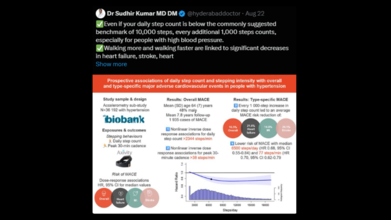- Health Conditions A-Z
- Health & Wellness
- Nutrition
- Fitness
- Health News
- Ayurveda
- Videos
- Medicine A-Z
- Parenting
- Web Stories
Intimidated By Running Exercises? Slow Running May Be Your Answer To This Cardio

Running is one of the best ways to fit exercise in your day. Many people enjoy endurance, muscle control, and the co-ordination test that comes with running. However, it can also be an intimidating task; many people are afraid to commit to running as it is not only tiring but also causes muscle spasm and fatigue for those who are not used to running. If the thought of running feels overwhelming or like a huge commitment, you are not alone. There's a less intimidating way to start, which is called slow running. This approach makes running accessible and enjoyable for everyone.
What is "Slow Running"?
The Cleveland Clinic explains that "slow running," also known as low-intensity running, is similar to jogging. The main idea is that by reducing your pace, you can cover more miles and train your body in several beneficial ways. This approach helps build endurance and strengthens your muscles, heart, and lungs.
Overall, it allows your body to adapt to the demands of running and helps prevent injuries, which will ultimately help you run faster in the long run. There's a lot of evidence showing how much your body's ability to use oxygen can improve with slow running.
The best way to understand slow running is to think of it as a comfortable jog. It's a pace where you can easily hold a conversation without huffing and puffing between words. You should even be able to sing along to music if you wanted to. It's an effort you could seemingly sustain forever.
Why Do People Go For Slow Running?
What "slow" means in terms of speed is different for everyone. For example, someone who typically finishes a 5K race in 18 minutes will have a "slow" pace that's still faster than someone who usually takes 25 minutes for a 5K.
When you finish a slow run, you might even feel like you could keep going, instead of feeling tired and out of breath. Your slow run should feel comfortable, not overly challenging.
The goal isn't to stop pushing yourself completely. It's about being smart with your training. You want a good mix of intense and easy runs. Most of your runs should be slow, while others should be where you push for speed. A good general rule is that about 80% of your runs should be slow, and the other 20% should be faster. However, this can depend on your training goals, experience, and past injuries.
If you track your heart rate, for most of your slow runs, you'll want to stay in Zone Two, which is typically around 55% to 65% of your maximum predicted heart rate.
Benefits of Slow Running
Still not convinced that running slower will help you achieve your speed goals? Here are some key benefits:
Builds Endurance
Slow running helps you improve your stamina and ability to resist fatigue. This is because it enhances the function of your mitochondria, which produce most of your body's energy. By running slowly, you can increase the number of mitochondria and improve oxygen delivery to your muscles, allowing you to run longer before feeling tired.
Strengthens Your Body
It helps your joints, ligaments, tendons, and bones adapt to the stress of running. It also strengthens your muscles, heart, and lungs. Running at a slower pace can help you focus on and improve your running technique.
Reduces Injury Risk
When you sprint or run fast, there's much more impact and demand on your body, increasing the risk of injury. Slow running reduces this wear and tear, helping you stay healthy and run longer over time. While there's a place for fast efforts, easy miles are crucial for injury protection.
Gradual Speed Improvement
By consistently building your endurance and heart efficiency through slow running, you'll notice that your "slow" pace gradually becomes faster over months or even a year. For example, if your slow runs are currently a 10-minute mile pace where you can easily chat, you'll find that over time, that same comfortable effort will result in a faster mile time.
No Longer Need 10,000 Steps? 2,500-4,000 Are Enough To Protect Your Heart, Says Doctor

Credits: Canva
For years, 10,000 steps a day has been seen as the gold standard for fitness. However, new medical perspectives suggest that walking fewer steps, if done correctly, can still provide significant health benefits. Hyderabad-based neurologist from Apollo Hospital, Dr. Sudhir Kumar, in a detailed post on X, explained why people should not feel discouraged if they fall short of the 10,000-step benchmark.
Rethinking the 10,000-Step Target
The 10,000-step goal originated decades ago as a marketing concept rather than a scientifically backed number. While it remains a popular target, experts now stress that the quality of walking matters as much as quantity. Walking at a brisk pace and steadily increasing one’s step count over time can greatly benefit cardiovascular health, especially for individuals with high blood pressure.
Dr. Kumar noted that the UK Biobank study, a large-scale health database, revealed how every additional 1,000 steps per day lowers the risk of heart-related conditions. Missing the 10,000 mark, therefore, does not negate the benefits of walking.
Evidence From the UK Biobank Study

According to the data, each 1,000-step increase in daily activity contributed to:
- A 17% reduction in major cardiovascular events
- A 22% lower risk of heart failure
- A 9% decrease in heart attacks
- A 24% reduction in strokes
These findings underscore that even modest increases in walking can create measurable differences in long-term health outcomes.
Brisk Walking Packs an Extra Punch
One of the most striking observations was that brisk walking during the most energetic 30 minutes of the day offered unique benefits, regardless of the total daily step count. Short bursts of faster-paced walking appeared to provide added protection against heart disease. This suggests that people who cannot reach higher step counts may still safeguard their health by incorporating short, brisk walks into their routines.
Lower Threshold, Higher Impact
Dr. Kumar emphasized that as few as 2,500 to 4,000 steps per day can significantly lower illness risk when compared with a sedentary lifestyle. This is especially encouraging for individuals who may struggle to achieve higher numbers due to age, chronic illness, or busy schedules.
He also pointed out that 1.3 billion adults worldwide live with hypertension, making walking an especially important and accessible form of preventive healthcare. Even small increases in activity, such as adding 1,000 steps daily, can meaningfully reduce complications associated with high blood pressure.
How to Start Building Healthy Habits
For those looking to improve their step counts, experts recommend a gradual approach. Increasing daily activity by 500 to 1,000 steps at a time helps individuals avoid burnout and makes it easier to sustain the habit long-term. Maintaining a brisk pace is equally important, as intensity plays a key role in cardiovascular benefits.
A Simple and Accessible Strategy
Walking requires no special equipment, gym memberships, or training, making it one of the most accessible strategies for improving heart health. Dr. Kumar concluded in his X post that people should focus less on obsessing over 10,000 steps and more on moving consistently, briskly, and progressively.
Ultimately, whether someone walks 3,000 or 9,000 steps, the key message is clear: every step counts toward better heart health.
What Is Bone Burnout? Why Gym Overtraining Is Causing Joint Pain In 20s

Credits: Canva
You must have heard of burnout- feeling drained, stressed, or completely wiped out but here’s the twist, burnout isn't all in your head. Your bones and joints suffer from it too. Overtraining, disregarding pain, or forcing your body to the limit can result in what specialists refer to as "bone burnout," resulting in joint pain and stiffness, as well as early-onset arthritis. Your skeleton labors in silence, so paying attention to your body, resting, and training intelligently isn't advice, it's survival for your bones.
Over the past decade, gym culture has shifted from being a niche interest to a defining lifestyle for young adults, especially in urban areas. Strength training, high-intensity interval workouts, and endurance-based exercises dominate fitness routines, social media feeds, and wellness conversations. Yet, while pushing the body to achieve peak performance has its benefits, there is a hidden risk many young adults are unaware of- bone burnout.
Bone burnout is the premature breakdown and wear and tear of bones and joints, brought on most often by overtraining, poor technique, and neglect of initial signs of stress. Not officially a medical diagnosis, the syndrome is being more widely referred to by orthopaedic experts as a developing problem among those in their 20s and 30s. It is most commonly presented with chronic joint pain, stiffness, swelling, and, in severe cases, premature arthritis like osteoarthritis.
Dr. Rakesh Rajput, orthopaedic surgeon, explains, "Today's young adults are overloading their joints and bones past their natural limits. Once cartilage starts breaking down and warning signals are neglected, enduring damage is done. Years down the road, what began as mild pain can progress to permanent joint issues."
How Modern Lifestyle Contributes to Joint Overload?
There are a number of factors why young adults are particularly susceptible to bone burnout. Unlike older individuals, younger people tend to overestimate their physical resistance. Numerous spend excessive amounts of time on weight training, functional fitness, and cardio workouts without adequate rest, warm-up, or recovery strategies. Deviant postural habits and repetitive strain also serve to increase wear on cartilage and joints.
Even minor misalignments while squatting, lunging, or running can speed up stress on hips, knees, and spine. Repetitive high-impact exercises like plyometrics or sprint intervals amplify damage, especially when added to improper footwear or poor diet. Young adults can also ignore pain, thinking it is a part of exercising, and not a warning sign.
Dr. Rajput adds, “Ignoring knee or back pain can compromise cartilage faster than natural aging. We’re seeing meniscus tears and early degenerative changes in patients as young as 20 to 30, conditions historically observed in much older adults or elite European athletes.”
What Is Bone Burnout?
Bone burnout targets mostly the cartilage, the tough but flexible tissue that lines joints and helps to absorb shock. While cartilage receives a limited supply of blood, unlike muscle, this lowers its ability to recover from frequent stress. If young adults participate in high-volume, high-intensity training without adequate rest, microtraumas develop. Over time, sometimes years, months, or decades, these tiny injuries develop into chronic inflammation, pain, and decreased mobility.
Study also indicates that repetitive overload can transform joint mechanics. Pathologic loading patterns load ligaments, tendons, and adjacent musculature, establishing a cascade of biomechanical problems. For instance, flawed squatting technique can stress the anterior cruciate ligament (ACL) and patellar tendon and cause lifelong knee instability.
Early Warning Signs of Bone Burnout to Watch Out For
Being able to recognize bone burnout early will prevent irreversible harm. Watch out for:
- Recurring joint stiffness or pain after training
- Swelling or redness over involved joints
- Decreased range of motion
- Increased pain with activity and decreased with rest
- Clicking, popping, or grinding noise in the shoulders or knees
Dr. Rajput states, "If these symptoms extend beyond a few days, it is essential to have medical evaluation. Prompt treatment can avoid long-term conditions and protect future mobility."
Smart Fitness Practices To Avoid Bone Burnout
Prevention of bone burnout involves a balanced strategy of intensity and recovery. Some of the most important strategies are:
Organized Warm-Ups and Cool-downs: Warming up muscles before intense exercise decreases joint strains. Dynamic stretching and low-impact movements acclimatize cartilage and tendons to stress.
Balanced Exercise: Integrating strength, flexibility, and endurance exercises prevents one muscle group or joint from overuse.
Recovery Days: Recovery is necessary for cartilage repair. Overtraining without recovery makes the body more susceptible to joint degeneration.
Footwear and Equipment: Support during high-impact activities lessens cumulative stress.
Nutrition: Sufficient calcium, vitamin D, and protein provide support for bone density and muscle recovery.
Monitoring Symptoms: Pain is not a badge of effort but should be considered a signal. Ignoring pain results in long-term effects.
Routine check-ups with orthopaedic doctors or sports physiotherapists by young adults who do high-volume training, particularly those with ongoing discomfort, are also suggested by Dr. Rajput.
Is There Any Treatment For Bone Burnout?
Prevention will always be the best way, but new developments in orthopaedic care are also now offering alternatives for individuals already suffering from bone burnout. Lifestyle changes, physiotherapy, and preventive treatment are first-line therapies. But for more severe cartilage or joint injury, new innovations deliver successful solutions:
Robotic-Assisted Surgery: Robotic-assisted precision systems enable knee and joint operations to be performed minimally invasively, facilitating quicker recovery and less post-operative complication.
Partial Knee Replacement or Joint Resurfacing: For active young adults with localized joint damage, these operations reduce pain and conserve natural joint tissue, putting off the necessity for total replacement.
Targeted Physiotherapy: Individualized rehabilitation programs restore normal movement patterns, minimize inflammation, and increase supportive musculature.
Dr. Rajput adds, "Even with surgery, these advancements enable young patients to preserve mobility, quality of life, and the capacity to remain active without long-term restrictions."
What Are The Long-Term Consequences of Disregarding Bone Burnout?
Ignoring bone burnout in one's 20s can give way to a lifetime of joint problems. Chronic pain, reduced mobility, and early-onset osteoarthritis are being seen with more frequency in younger people, affecting both daily life and career. In addition, adaptations to move in a way that is less painful can result in secondary injuries to hips, back, and shoulders, leading to a chain of musculoskeletal ailments.
Bone burnout is a grim reminder that intensity without intelligence can be a trap. While young adults stand to gain much from living a physically active life, excessive training without a guide can hasten joint wear and tear. The silver lining is that with intelligent exercise programs, early symptom detection, and contemporary medical techniques, bone burnout can be prevented and controlled.
Dr. Rajput has this to say: "Fitness should add life, not detract from it. Young adults need to focus on joint health, listen to their body, and apply strategies that blend performance and preservation. Avoiding bone burnout now means an active, healthy future.
Dr. Rakesh Rajput is an orthopaedic surgeon, HOD & Director – Orthopaedics at CMRI Kolkata in India
10 Fitness Myths You’ve Probably Fallen For And Why You Should Forget About

Credits: iStock
Every January or more accurately each new month, gyms are full of people chasing fitness objectives, expecting this time things will be different- gain muscle, lose weight, or just feel healthier. With that increase in motivation follows a new wave of that seemingly limitless "fit-buddy" tips that is typically contradictory to the established facts that fills up fitness culture. Perhaps you've heard that treadmill running is better for your knees than pavement running. Or that stretching before each and every workout is absolutely essential if you don't want to get hurt. These claims sound convincing, but many of them don’t hold up to scientific scrutiny.
The fitness industry has a long tradition of handing down rules of thumb without ever stopping to wonder where they came from. But exercise physiology and sports medicine science has a very different tale to tell. Elliott Morgan, host of the Mental Floss YouTube channel, breaks down and debunks 10 common workout myths in his video, “Misconceptions About Exercise.” To train smarter not harder it's worth distinguishing fact from fiction. Let’s break down ten of the most common workout myths, and what the evidence really shows.
Myth 1: Treadmill Running Is Easy on the Knees
It's tempting to think treadmills are easier on the knees due to their cushioned belts, but studies tell a different story. Runners tend to shorten their stride when running indoors, bouncing and over-striding in ways that end up putting more stress on the joints. Outdoor running isn't necessarily worse—the most important things are technique, shoes, and slowly increasing distance to prevent overuse injuries.
Myth 2: Change Running Shoes Every Six Months
No six-month magic. The shoe life cycle is determined by your body weight, running technique, mileage, and type of shoe. Some runners wear out as many as 600 miles or more in one pair. Rather than using the calendar, listen to comfort, cushioning, and overt wear. Your body will typically indicate it's time to change.
Myth 3: Stretching Averts Injuries
Static stretching prior to exercise does not decrease injury risk—instead, it temporarily weakens muscles. According to a 2013 Journal of Strength and Conditioning Research study, static stretching decreased muscle power by approximately 2%. That is not an invitation to omit warming up. Dynamic stretches and low-intensity movement-based drills are more effective methods of getting muscles ready for activity without blunting performance.
Myth 4: If You're Not Sweating, You're Not Working Hard
Sweat is your body's means of cooling itself down, not a literal indicator of effort. Heredity, water intake, and surroundings all affect how much you sweat. Someone can burn serious calories with a low-sweat activity such as weightlifting or yoga, while another person sweats buckets on a brisk walk. Effort, not sweating, is what matters.
Myth 5: Sweating Flushes Out Toxins
The notion that sweat cleanses your body has persisted, but it's inaccurate. Sweat consists primarily of water and electrolytes, with trace toxins making up only 1% of the constituents. Detoxification's heavy lifting occurs in your liver, kidneys, and digestive system. Saunas and hot yoga can be invigorating but are not a replacement for the body's natural detox processes.
Myth 6: Calorie Counters on Machines Are Accurate
The figure flashing before you on the treadmill isn't scripture. Machines tend to overestimate burn rates since they can't correct for body composition, age, sex, or effort. Ellipticals especially can overestimate calorie counts by more than 40%. Treadmills are closer to reality, particularly when you plug in your weight. But to be absolutely accurate, wearable heart-rate monitors and metabolic tests are much better.
Myth 7: Sit-Ups Alone Will Give You a Six-Pack
Sit-ups and crunches are core exercises that build strength but won't miraculously burn belly fat. Spot reduction, losing weight in a specific targeted area, has been debunked time and again. Visible abs depend on a combination of strength training, cardio, and a well-balanced diet to cut down overall body fat. A six-pack is as much about nutrition as it is about a gazillion sit-ups.
Myth 8: Cardio Always Burns More Calories Than Strength Training
Cardio may burn more calories while you're actually doing the exercise, but strength training has a strong after-effect. Due to excess post-exercise oxygen consumption (EPOC), weight lifting increases metabolism for several hours after you're done at the gym. In reality, a program that includes a mix of cardio and resistance training usually gives the best fat loss, performance, and long-term health results.
Myth 9: Maximum Heart Rate = 220 – Age
This equation is a common usage but infrequently accurate. It tends to overestimate heart rate zones for younger individuals and underestimates heart rate zones for older individuals. The American Council on Exercise stresses there's no such thing as the ultimate one-size-fits-all formula. If you need precision, laboratory testing or consulting with a coach gives way more useful numbers than a straightforward subtraction formula.
Myth 10: No Pain, No Gain
The catchphrase has motivational appeal, but pain is not the objective. Some soreness and discomfort are okay, but sharp or ongoing pain is a red flag for injury. Specialists emphasize listening to your body: it's possible to build strength by pushing through exhaustion, but pushing through actual pain can lead to long-term harm. Rest is equally essential to making progress.
Why Its Important To Rethink Fitness Advice?
Myths about exercise linger because they're memorable, simple to repeat, and in some cases based on half-truths. But holding on to them can hold us back—resulting in wasted effort, frustration, or even injury. The true intention isn't to train harder for the sake of it, but to train smarter.
Science shows us that fitness isn’t about rigid rules, it’s about adapting to your body’s needs, training consistently, and pairing exercise with good nutrition and rest. Whether you’re running, lifting, or doing yoga, the most effective routine is the one that balances effort with evidence.
Disclaimer: This article is for informational purposes only and should not be taken as medical advice. Always consult a qualified healthcare or fitness professional before making changes to your exercise routine, diet, or lifestyle. Individual results may vary.
© 2024 Bennett, Coleman & Company Limited

